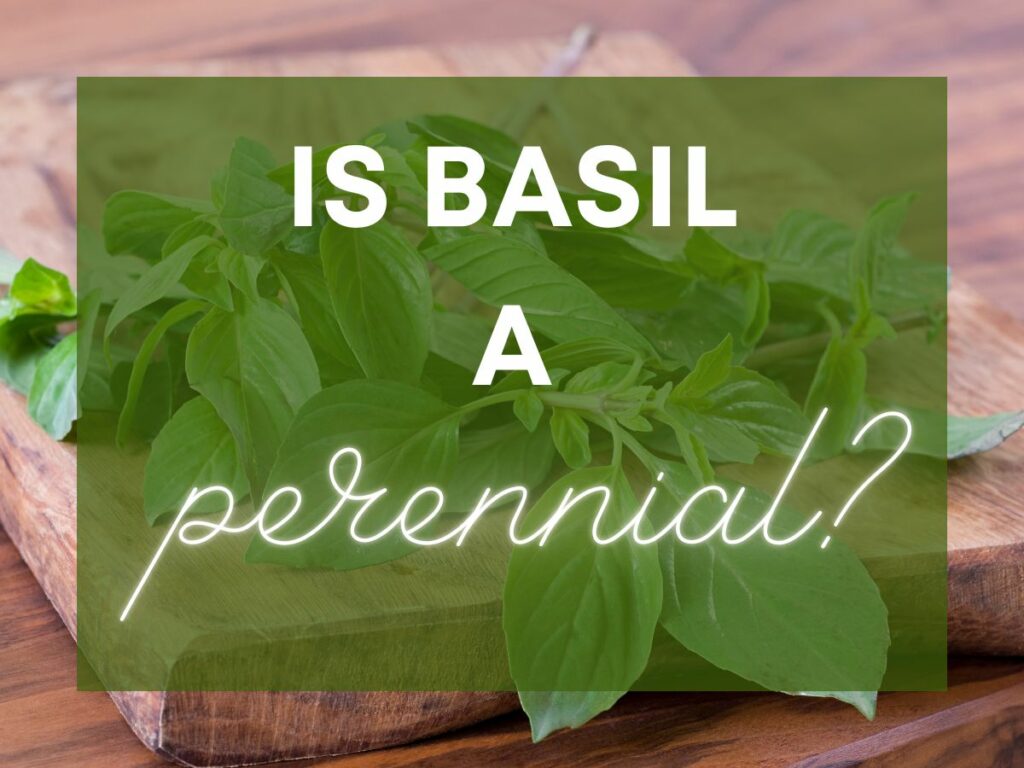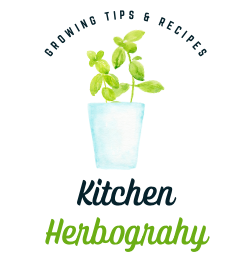As an Amazon Associate I earn from qualifying purchases. This website also participates in other affiliate programs and may earn commissions if you shop through the links used on this website.
(This article was originally published on August 22, 2022 and was last updated on September 3, 2022)
If you love to add basil to your culinary creations, having a consistent supply of delicious sweet basil leaves throughout the year is ideal. But is that even possible? Below, we answer all your questions about the basil lifecycle. Namely: is basil a perennial or annual herb?
Basil (Ocimum basilicum) is a well-known culinary and medicinal herb that plays a prominent role in countless food items and drinks, and has done so throughout history. The most common form of basil gracing kitchens is sweet basil and Genovese basil, which many cooks keep nearby to throw on pizza or make fresh pesto with. However, there are over 100 known varieties of basil you can grow, eat, and add unique flavors to your dishes.
Since basil is relatively easy to grow, experienced and hobby gardeners alike love to work with it. And while basil goes hand in hand with summertime, most of us would prefer to have an ongoing supply of fresh basil year-round.
But, is this even possible? Can basil be grown all year as a perennial herb, or are the delicious leaves only available during a short growing season?
More importantly, will your basil plants return on their own next summer? Or do you need to replant basil every year?
In most cases, basil is an annual herb. However, there are some exceptions to that rule, particularly if you’re growing in warmer climates.
This article explores the differences between annual and perennial basil. It also covers some strategies you can use if you’re wondeirng how to grow basil year round.

Is Basil a Perennial or Annual Plant?
When you purchase seed packets from a garden store, there’s a notation indicating whether the plant is annual or perennial.
But what exactly does that mean, and what’s the difference between annual and perennial herbs?
An annual plant is one that doesn’t survive frost and the cold of winter. Annual herbs die – either with the first frost or during the first hard freeze when the cold winter sets in. Basil plants are frost sensitive, and can turn black or wilt and shrivel in cold weather. In most growing zones, growing basil needs to be done as annual herbs, because the basil plants won’t survive the initial temperature drop when fall or winter hits.
However, there’s an exception! USDA Hardiness Zones 11-13 do not experience regular frosts during the winter. So if you live in one of these areas, your annual plants’ life will get extended. In some cases, they can even grow perennial basil in these zones.
True perennial herbs will survive through tough winter frosts and freezes. Some perennial plants even thrive in these conditions, as long as they get covered during the worst cold snaps. Others will die off due to the cold weather but effectively go into a hibernation state. Once the weather (and soil) warm up again, they will spring back to life.
Basil is not one of these true perennial herbs, but it can more or less be grown as such in areas without frost and cold.
Is Basil a Perennial or an Annual?
Most basil varieties, including the ever-popular Genovese basil and sweet basil, are annual plants. Basil is extremely frost sensitive and will die once the first frost hits in the fall or winter, unless it’s brought inside or otherwise prepared to grow throughout the winter (i.e in a green house).
However, in USDA Hardiness Zones 11-13, you can grow perennial basil until the plant reaches the end of its life cycle.
Additionally, some basil varieties are true perennial herbs. Theses types of basil will self-seed and continue to grow for years to come.
How Long Does a Basil Plant Live?
Different basil plants have different survival rates. The life of your basil plant is determined by whether it is growing as a perennial or annual.
Perennial Basil
Perennial basil has a stockier and sturdier stem. These plants will survive between 3-4 years, provided they are well cared for. You want to ensure ample sun (ideally full sun), well drained soil and quality potting soil, and enough water to keep the ground moist. If you experience frosts or freezes, offer protection such as row coverings to extend their growing season.
When you take all these steps, your perennial basil plant should last for a few years. You do not want to let them live past 4 years, however. As basil plants age, the leaf quality starts to deteriorate. To ensure the highest quality and most abundant leaf growth, replant every few years.
Is There a True Perennial Basil?
There is a true perennial basil, known as wild basil (Clinopodium Vulgare). This distinctive basil variety can be found growing wild in many northern climates. Its leaves are edible, just like those of its relatives. They typically pack a milder flavor punch.
If you can source some of these seeds, or a starter plant at a nursery, you may want to consider adding this unique basil plant to your garden.
(Note: We found some wild basil seeds on Etsy, but haven’t used them personally so can’t vouch for their quality. See them here.).
Annual Basil
Most basil is grown as an annual herb, unless you grow indoors or in a warm region.
If your annual basil lives in the garden, it will only last through the growing season, or until it flowers. Depending on the nature and length of your specific growing season, this could range from late spring to early fall. Some regions have significantly shorter growing seasons, as the soil does not warm until early summer and the frosts come early. In those areas, you may only get a few solid months of quality harvest from your basil plants.
But, if you are growing your annual basil plants in containers or a hydroponic system, they will last much longer. With proper care and with adequate space and conditions, indoor basil plants could produce an abundant harvest for a solid year, and could even serve as a mother plant for a basil cutting. You may even be able to encourage leaf production for a little over a year with plenty of harvesting and perfect conditions (and a bit of luck). However, at that point the leaves would be sparse and not as flavorful.
Does Basil Die in Winter?
The best way to keep your annual basil plants alive in winter is to grow them in containers. During the warmth of the summer, you can keep those containers outside with the rest of your plants. Doing so will ensure a consistent supply of nourishing sunlight.
As the seasons shift, you can bring your containers in at night or on cold days. Once the cold settles in, you can leave your containers inside full-time. But remember, growing basil indoors requires access to either 6-8 hours of direct sunlight or an artificial light / grow light to keep them healthy.
Greenhouses
Another option for growing basil in the winter is in greenhouses. If you have enough space and the interest in keeping one up, they are a fantastic solution for areas with short growing seasons.
Greenhouses will allow you to take advantage of the powerful winter sun while shielding your delicate basil plants from the harsh cold. As with growing in your garden, you want to make sure they have healthy growing conditions to prevent pests munching holes in the leaves, discoloration such as brown spots or white spots, or yellowing of the basil plant or leaves.
How to Grow Perennial Basil
Should you live in a growing zone that falls between 11 and 13, you don’t need to take too many extra steps to grow perennial basil successfully. Follow your standard gardening processes. Ensure your basil plants have exposure to full, direct sunlight if possible, or at least partial sun if not. Provide enough water to keep the soil moist but not soggy. And prune the basil leaves in a way that will allow for bushy, productive plants to grow.
True perennial basil can withstand minor frosts. So, if you live closer to zone 11 and are growing perennial basil, don’t worry about the occasional frost. In most instances, your basil will be just fine.
When perennial basil is cared for properly, it will remain productive for approximately 3-4 years. The production of your basil will slow toward the end of its life, and the flavor of the leaves will noticeably diminish. So you do want to replant before this happens.
There are a few ways to do this. You can choose to replant every year, or you can succession plant.
Growing New Basil Plants Every Year
To ensure an abundant and regular supply of basil, you can opt for replanting basil every year. Doing so will provide you with more than enough basil leaves for harvesting. When the leaf quality of your older plants starts to diminish, your newer plants will have large and flavorful leaves at the ready.
Living in warmer zones means basil seeds can safely get started outdoors without the risk of frost or cold weather impacting the germination rate.
Or, if you prefer, you can still start your basil seedlings indoors. If you do, offer plenty of light (preferably under a growing light) and harden them off properly before transplanting.
Succession Planting
The easiest way to allow your basil plants to re-seed themselves while still producing enough basil leaves for an abundant harvest is a process called succession planting. Essentially, succession planting is starting another round of basil seeds a few weeks after the first. If your goal is to grow a large basil plant (or plants!), you will want to choose a different spot in the garden for each round of planting.
A few weeks after your basil plants develop, go ahead and plant another round of seeds. As soon as those have reached the point where you can start harvesting leaves, let the initial plants develop flowers and produce seeds, which you can collect for more planting.
What to do With Basil Flowers?
Basil with flowers attracts beneficial pollinators to your garden. They are also how basil seeds develop. Allow the flowering basil to run its full course. When you see the flowers begin to dry out, you have two different options.
You can allow them to fall off, scattering their seeds all over the garden. When this happens, your basil plants are effectively self-seeding themselves. You will likely find basil plants popping up voluntarily and fairly abundantly. It will ensure you have a continuous and productive basil garden.
But you can also harvest some of the basil seeds. Harvesting your basil seeds is easy.
You should remove the flowers before they fall off to avoid losing the precious seeds. Then you can process the flowers, dry the seeds and store them for future use.
Additionally, basil flowers are edible. So if you allow your early basil plants to go to flower, you can add some of them to delicious summer salads or tasty beverages. Basil flowers can also be thrown in when you’re making pesto.
So…Can I Grow Basil Year Round?
Yes, you can grow basil year round.
Annual basil plants can grow in warm indoor environments all year, if you are gardening below Zone 11.
Or, you can choose to grow wild basil – a true perennial basil – in your outdoor garden.
If you live somewhere between Zones 11 and 13, get ready to enjoy abundant and year-round basil harvests. Since basil thrives in warmer, frost-free environments, you can successfully grow basil as a perennial plant even outdoors in these areas.
Jennifer is a writer, Nutritionist, and Herbalist who loves all things food. She grows basil alongside other herbs and edible flowers in her garden. Herbs also hold a prominent space in her aerogarden. She enjoys experimenting in the kitchen, finding fun and unique ways to incorporate herbs into daily life. Jennifer is passionate about helping others discover the joy of quality food. And she loves to bring her two kids along on endless food adventures!

